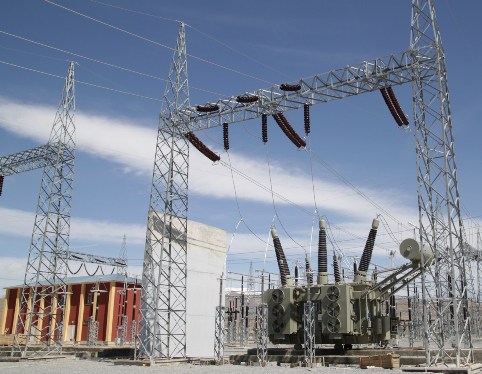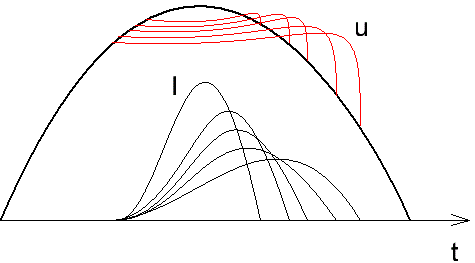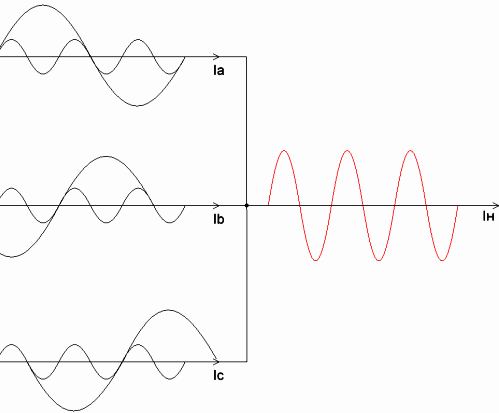Reasons for the appearance of higher harmonics in modern power systems
The electrical equipment of the modern world is becoming more and more complex, especially for IT technologies. Because of this trend, power quality assurance systems must meet these requirements: they simply must easily handle fluctuations, surges, voltage dips, noise, impulse noise, etc., so that the industrial network and related its users to be able to function normally.
Grid voltage reshaping due to harmonics caused by non-linear loads is one of the main problems to be solved. In this article, we will look at the in-depth aspects of this problem.

What is the essence of the problem
The main share of the current office equipment, computers, office, multimedia equipment are generally non-linear loads, which, connected in the common power network in huge quantities, distort the shape of the network voltage.
This distorted voltage is painfully perceived by other electrical devices and sometimes significantly disrupts their normal operation: it causes malfunctions, overheating, breaks synchronization, generates interference in data transmission networks, — in general, non-sinusoidal alternating voltage can cause a whole variety of equipment, processes and inconvenience to people, including material.

The voltage distortion as such is described by a pair of coefficients: the sinusoidal factor, which reflects the ratio of the rms value of the higher harmonics to the rms value of the fundamental harmonic of the network voltage, and the load crest factor, equal to a ratio of the peak current consumption to the effective load current.
Why are higher harmonics dangerous?
The effects caused by the manifestation of higher harmonics can be divided according to the duration of exposure into immediate and long-term. It is common to mention instantaneous: supply voltage shape distortion, distribution network voltage drop, harmonic effects including harmonic frequency resonance, harmful interference in data transmission networks, noise in the acoustic range, vibration of machinery. Long-term problems include: excessive heat losses in generators and transformers, overheating of capacitors and distribution networks (wires).
Harmonics and line voltage shape
Significant peak currents in half of the network sine wave lead to an increase in the crest factor.The higher and shorter the peak current, the stronger the distortion, while the comb factor depends on the capabilities of the power source, on its internal resistance - whether it is able to deliver such a peak current. Some sources must be overrated in relation to their rated power, for example special windings must be used in generators.
But uninterruptible power supplies (UPS) cope with this problem much better: due to the double conversion, they are able to control the load current at any moment and regulate it using PWM, which avoids problems due to the high coefficient of comb of the current. In other words, the high crest factor is not an issue for a quality UPS.
Higher harmonics and voltage drop
As noted above, UPSs handle high crest factors well and their waveform distortion does not exceed 6%. Connecting wires here, as a rule, do not matter, they are quite short. But due to the abundance of harmonics in the line voltage, the current waveform will deviate from sinusoidal, especially for odd high-frequency harmonics introduced by single-phase and three-phase rectifiers (see figure).

The complex impedance of the distribution network is usually inductive nature, therefore, current harmonics in large quantities will lead to significant voltage drops on lines 100 meters long, and these drops can exceed the permissible ones, as a result of which the voltage shape on the load will be distorted.
As an example, note how the output current of a single-phase diode rectifier changes at different network impedances, depending on the resistance of the input filter of a powered device with a transformerless input, and how this affects the voltage waveform.
The problem of harmonics multiples of the third
Third, ninth, fifteenth, etc. — the higher harmonics of the mains current are characterized by high amplitude coefficients. These harmonics arise from single-phase loads and their effect on three-phase systems is quite specific. If the three-phase system is symmetrical, the currents are displaced from each other by 120 degrees, and the total current in the neutral wire is zero, — there is no voltage drop across the wire.

This is true in theory for most harmonics, but some harmonics are characterized by rotation of the current vector in the same direction as the current vector of the fundamental harmonic. As a result, in the neutral the odd harmonics that are multiples of the third are superimposed on each other. And since these harmonics are in the majority, the total neutral current can exceed the phase currents: say, phase currents of 20 amperes will give a neutral current with a frequency of 150 Hz at 30 amperes.
A cable designed without taking into account the influence of harmonics can overheat because, according to the mind, its cross-section should have been increased. Harmonic multiples of the third are offset in a three-phase circuit by 360 degrees relative to each other.
Resonance, interference, noise, vibration, heating
Distribution networks have danger of resonance at higher current or voltage harmonics, in these cases the harmonic component turns out to be higher than the fundamental frequency, which negatively affects system components and equipment.
Data transmission networks located near power lines through which currents with higher harmonics flow are subject to interference, the information signal in them deteriorates, while the shorter the distance from the line to the network, the greater is the length of their connection, the higher the harmonic frequency — the greater the distortion information signal.
Transformers and chokes start to make more noise due to higher harmonics, electric motors experience pulsations in the magnetic flux, resulting in torque vibrations on the shaft. Electrical machines and transformers overheat and heat losses occur. In capacitors, the dielectric loss angle increases with a frequency higher than the grid, and they begin to overheat, dielectric breakdown may occur. It is unnecessary to talk about the losses in the lines due to the increase in their temperature ...
